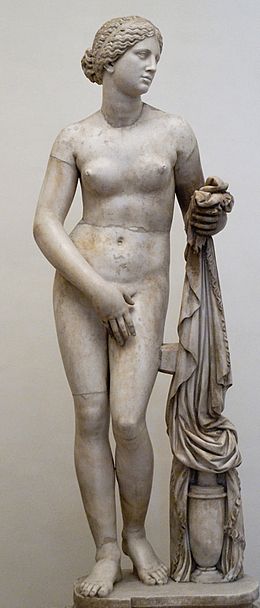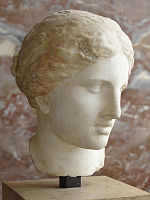- Aphrodite of Cnidus
-
The Aphrodite of Cnidus was one of the most famous works of the ancient Greek sculptor Praxiteles of Athens (4th century BC). It and its copies are often referred to as the Venus Pudica ("modest Venus") type, on account of her covering her naked vulva with her right hand. Variants of the Venus Pudica (suggesting an action to cover the breasts) are the Venus de' Medici or the Capitoline Venus.
Contents
Original
The statue became famous for its beauty, meant to be appreciated from every angle, and for being the first life-size representation of the nude female form. It depicted the goddess Aphrodite as she prepared for the ritual bath that restored her purity (not virginity), discarding her drapery in her left hand, while modestly shielding herself with her right hand.
According to a possibly apocryphal account by Pliny, Praxiteles received a commission from the citizens of Kos for a statue of the goddess Aphrodite. Praxiteles then created two versions—one fully draped, and the other completely nude. The shocked citizens of Kos rejected the nude statue and purchased the draped version. The design and appearance of the draped version is today unknown as it didn't survive, nor did it appear to have merited attention, to judge from the lack of surviving accounts.
The rejected nude was purchased by some citizens of Knidos and set up in an open air temple that permitted viewing of the statue from all sides. It quickly became one of the most famous works by Praxiteles for the bold depiction of Aphrodite as proudly nude.
Praxiteles was alleged to have used the courtesan Phryne as a model for the statue, which added to the gossip surrounding its origin. The statue became so widely known and copied that in a humorous anecdote the goddess Aphrodite herself came to Knidos to see it. A lyric epigram of Antipater of Sidon[1] places a hypothetical question on the lips of the goddess herself:
The statue became a tourist attraction in spite of being a cult image and patron of the Knidians. Nicomedes I of Bithynia offered to pay off the enormous debts of the city of Knidos in exchange for the statue, but the Knidians rejected his offer. The tradition—apparently prompted by a stain in the marble on the rear of one thigh—that the statue was so lifelike that a young man secreted himself in the cella at night and attempted to copulate with it[2] is recorded in the dialogue Erotes (section 15), traditionally misattributed to Lucian of Samosata. The dialogue offers the fullest literary description of the temenos of Aphrodite at Knidos:
- The floor of the court had not been doomed to sterility by a stone pavement, but on the contrary, it burst with fertility, as behooves Aphrodite: fruit trees with verdant foliage rose to prodigious heights, their limbs weaving a lofty vault. The myrtle, beloved by the goddess, reached up its berry-laden branches no less than the other trees which so gracefully stretched out. They never know foliage grown old, their boughs always being thick with leaves. To tell the truth, you can notice among them some infertile trees, but they have beauty as their fruit. Such were the cypress and the planes which towered to the heavens, as well as the tree of Daphnis, who once fled Aphrodite but now has come here to seek refuge. Ivies entwine themselves lovingly around each of these trees. Heavy clusters of grapes hang from the gnarled vines: indeed, Aphrodite is only more attractive when united with Bacchus; their pleasures are sweeter for being mixed together. Apart, they have less spice. Under the welcome shade of the boughs, comfortable beds await the celebrants— actually the better people of the town only rarely frequent these green halls, but the common crowds jostle there on festive days, to yield publicly to the joys of love. (Pseudo-Lucian, Erotes)
Of the Aphrodite herself, the narrator resorts to hyperbole:
- When we had exhausted the charms of these places we pressed on into the temple itself. The goddess stands in the center; her statue made of marble from Paros. Her lips are slightly parted by a lofty smile. Nothing hides her beauty, which is entirely exposed, other than a furtive hand veiling her modesty. The art of the sculptor has succeeded so well that it seems the marble has shed its hardness to mold the grace of her limbs (Pseudo-Lucian, Erotes)
Copies
The Cnidian Aphrodite has not survived. Possibly the statue was removed to Constantinople (modern Istanbul) and was lost in a fire during the Nika riots. It was one of the most widely copied statues in the ancient world, so a general idea of the appearance of the statue can be gleaned from the descriptions and replicas that have survived to the modern day. For a time in 1969, the archaeologist Iris Love thought she had found the only surviving fragments of the original statue, which are now in storage at the British Museum. The prevailing opinion of archaeologists is that the fragment in question is not of the Knidia, but of a different statue.
- Probably the most faithful replica of the statue is the Colonna Venus conserved in the Museo Pio-Clementino, part of the collections of the Vatican Museums.
- The Kaufmann Head, found at Tralles, purchased from the C.M. Kaufmann collection, Berlin, and conserved in the Musée du Louvre, is thought to be a very faithful Roman reproduction of the head of the Knidian Aphrodite.[3]
- At Hadrian's Villa near Tivoli in Italy, there is a second-century recreation of the temple at Knidos with a fragmentary replica of the Aphrodite standing at the center of it, generally matching descriptions in ancient accounts of how the original was displayed.
As well as more or less faithful copies, the Aphrodite of Cnidus also inspired various variations, which include:
- the Capitoline Venus (Capitoline Museums, Rome)
- the Barberini Venus
- the Borghese Venus
- the Venus of Arles (Louvre, Paris)
- the Aphrodite of Melos (the Venus de Milo, Louvre, Paris)
- the Venus de' Medici (Uffizi Gallery, Florence)
- the Esquiline Venus (Capitoline Museum, Rome)
- Venus of the Esquiline type (Louvre, Paris)[1]
- the Crouching Venus (Louvre, Paris and British Museum, London)
- the Aphrodite Kallipygos (aka Venus Kalypygos, Museo Archeologico Nazionale Napoli, Naples)
- the Venus Victrix (Uffizi Gallery)
- Venus Urania (Uffizi Gallery)
- The Mazarin Venus, named after Cardinal Mazarin (now in the J. Paul Getty Museum)[2]
- An example with added figures of Pan and Cupid at the Athens National Archaeological Museum.[3]
- The Venus Felix at the Vatican Museums, a possible variation of the type.[4]
Notes
- ^ Antipater, Greek Anthology XVI.168 [The author of this poem is listed as anonymous in the Loeb edition (The Greek Anthology Vol. V., p. 257).]
- ^ Cf. the Hellenistic anecdote of Pygmalion.
- ^ "The head from Martres Tolosanes and, especially, the so-called Kaufmann appear to me the best extant replicas" (Charles Waldstein, "A Head of Aphrodite, Probably from the Eastern Pediment of the Parthenon, at Holkham Hall", The Journal of Hellenic Studies 33 (1913:276-295) p. 283; "general agreement on the genuineness of the Kaufmann Collection Aphrodite as a replica of the Cnidian aphrodite" (Robert I. Edenbaum, "Panthea: Lucian and Ideal Beauty" The Journal of Aesthetics and Art Criticism" 25.1 (Autumn 1966:65-700 p. 69.
External links
- Entry page for the Vatican Museums.
- James Grout: Aphrodite of Cnidus, part of the Encyclopædia Romana
References
- Theodor Kraus. Die Aphrodite von Knidos. Walter Dorn Verlag, Bremen/Hannover, 1957.
- Leonard Closuit. L'Aphrodite de Cnide: Etude typologique des principales répliques antiques de l'Aphrodite de Cnide de Praxitèle. Imrimerie Pillet - Martigney, 1978.
- Francis Haskell and Nicholas Penny. Taste and the Antique: The Lure of Classical Sculpture, 1500-1900. Yale University Press, New Haven/London, 1981.
- Christine Mitchell Havelock. The Aphrodite of Knidos and Her Successors: A Historical Review of the Female Nude in Greek Art. University of Michigan Press, 1995.
Categories:- 4th-century BC Greek sculptures
- Sculptures by Praxiteles
- Lost sculptures
- Cnidian Venuses
Wikimedia Foundation. 2010.





